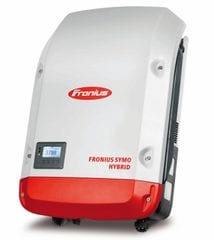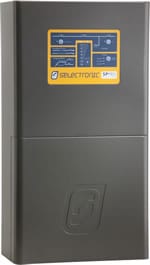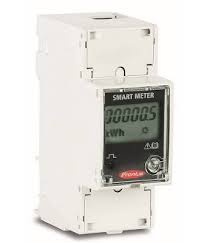In the solar power industry the latest thing that everyone wants is a battery ready solar power system, and many companies are scrambling over each other to provide solar power solutions which, we are told, are “battery ready.”
How a solar power system with a battery bank works
The term “battery ready solar power system”
For 2016 it looks like it’s the new catch cry of solar power sales people, yes I can assure you that this solar power system is battery ready! But buyer beware, as the term battery ready is a very loose and open ended term, as okay you may one day be able to connect a battery bank to your solar power system but just how much work and additional components will that require? Will it just be a matter of buying a compatible battery bank to connect into the system or will thousands and thousands of additional dollars be required to actually get the battery bank to work with your system?
You see the issue here is that in both cases a solar power system can be called “battery ready” by a sales person but the difference is in how much extra work and components are required to actually get the solar power system working in conjunction with a battery.
What’s required for a solar power system to be really battery ready?
Solar panels – this ones pretty obvious, for a solar power system to be what it is you need solar panels!
 Solar Inverter – this is one of the areas where everything gets a bit grey. There are hybrid solar inverters on the market which are the most battery ready inverters available. For 3 phase supplies we recommend the Fronius SYMO hybrid inverter, for single phase systems we recommend the SolarEdge StorEdge solar inverter.
Solar Inverter – this is one of the areas where everything gets a bit grey. There are hybrid solar inverters on the market which are the most battery ready inverters available. For 3 phase supplies we recommend the Fronius SYMO hybrid inverter, for single phase systems we recommend the SolarEdge StorEdge solar inverter.
DC Coupled Battery Ready Solar Power Systems
Both these solar inverters are designed to be “DC coupled” to a battery bank such as the Tesla PowerWall; this is the most efficient way to connect a battery bank as the system is designed to take the DC solar power generated by the solar panels and send it onto the batteries as DC power.
AC Coupled Battery Ready Solar Power Systems
Most other solar inverters out there which can connect to battery banks and may be classed as battery ready use what’s called an “AC coupled” system to take the power from your solar panels to the battery. This is quite inefficient as the DC power from the solar panels is converted by the inverter into AC power, then back to DC power to charge the batteries. When the power stored in the batteries is required it is then once again converted from DC to AC for use. Each of these conversions from DC to AC and AC to DC lowers the efficiency of the system which is why it’s not recommended as the best option for a battery ready solar power system.
 Most of the leading grid connect solar inverters on the market can potentially be called “battery ready” as they can be connected to additional products which can then be used to charge batteries, however these additional products are not cheap! For example an SMA SunnyBoy solar inverter can be connected to another SMA product, the Sunny Island and then connect to batteries, however this would cost over $6000 extra on top of your original system to connect to batteries – that’s before the additional cost of the batteries! ABB Aurora inverters can work in a similar way with a Selectronic SP Pro on grid inverter, but once again it is going to cost you around $6000 to set this up on top of your original system price before you even look at adding batteries.
Most of the leading grid connect solar inverters on the market can potentially be called “battery ready” as they can be connected to additional products which can then be used to charge batteries, however these additional products are not cheap! For example an SMA SunnyBoy solar inverter can be connected to another SMA product, the Sunny Island and then connect to batteries, however this would cost over $6000 extra on top of your original system to connect to batteries – that’s before the additional cost of the batteries! ABB Aurora inverters can work in a similar way with a Selectronic SP Pro on grid inverter, but once again it is going to cost you around $6000 to set this up on top of your original system price before you even look at adding batteries.
Electricity Meter – this is not your standard meter that your power company reads but a separate electricity meter which communicates with your battery control system to tell  the batteries what to do. It constantly monitors the power consumption of your property and this important data is used to tell the inverter what to do with the power from the batteries and from the solar panels. If the solar power system is producing more power than your property is consuming it will automatically send the required solar power to be used to power your appliances and send the surplus power to charge the batteries. If the property starts using more power than the solar is providing it will draw the additional power as required from the batteries. Obviously this electricity meter is a crucial component to maximise the self consumption of your solar power; if you are wanting your solar power system to be battery ready we highly recommend getting the electricity meter to suit the battery storage system initially, as the data that this meter provides will help you select the optimum sized battery when you are ready to look at them.
the batteries what to do. It constantly monitors the power consumption of your property and this important data is used to tell the inverter what to do with the power from the batteries and from the solar panels. If the solar power system is producing more power than your property is consuming it will automatically send the required solar power to be used to power your appliances and send the surplus power to charge the batteries. If the property starts using more power than the solar is providing it will draw the additional power as required from the batteries. Obviously this electricity meter is a crucial component to maximise the self consumption of your solar power; if you are wanting your solar power system to be battery ready we highly recommend getting the electricity meter to suit the battery storage system initially, as the data that this meter provides will help you select the optimum sized battery when you are ready to look at them.
Buyer Beware! An important point to keep in mind
A point that needs raising in regards to battery ready solar power systems is what happens if there’s a power failure and you lose power from the grid? If your intending to put in a battery storage system you’re probably just expecting power will be available from your batteries if the grid goes down – right? Well BEWARE! – this is not necessarily the case!
The battery ready systems we offer do allow for backup power, but beware that quite often this is not the case! It’s worth asking the question as you don’t want to find out when there’s a blackout and you were expecting to have power.
In conclusion – battery ready solar power systems
As we have discussed many standard grid connect solar power systems can be called “battery ready” however if you ever wanted to upgrade the system to actually work with batteries you would be looking at potentially more than $5000 in additional costs to get the system ready to work with batteries; and that cost is before the cost of batteries.
At Gold Coast Solar Power Solutions we highly recommend if you want to install a solar power system that is truly “battery ready” to initially install an inverter system which can be DC coupled to the batteries such as the 3 phase Fronius SYMO hybrid inverter system or the Single phase SolarEdge StorEdge solar inverter. This will be the most efficient system which is ready for any future technological advances – DC coupled systems are the future without a doubt. We also highly recommend installing an electricity meter with the initial installation as it will provide valuable data on your power requirements and will be invaluable in sizing the optimal battery storage to go with your solar power system – a system that is truly battery ready!

Got A Question About Solar Power? Click Here For Answers!
- Can you add more solar panels to your solar power system?
- How much power can you expect from your solar power system?
- Do you know how to read your Energex solar power meter?
- How to make the most of the 44c feed in tariff
- How to get the most out of your solar power system on a low feed in tariff

